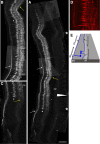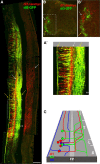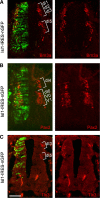Motor and dorsal root ganglion axons serve as choice points for the ipsilateral turning of dI3 axons
- PMID: 21084609
- PMCID: PMC6633670
- DOI: 10.1523/JNEUROSCI.2380-10.2010
Motor and dorsal root ganglion axons serve as choice points for the ipsilateral turning of dI3 axons
Abstract
The axons of the spinal intersegmental interneurons are projected longitudinally along various funiculi arrayed along the dorsal-ventral axis of the spinal cord. The roof plate and the floor plate have a profound role in patterning their initial axonal trajectory. However, other positional cues may guide the final architecture of interneuron tracks in the spinal cord. To gain more insight into the organization of specific axonal tracks in the spinal cord, we focused on the trajectory pattern of a genetically defined neuronal population, dI3 neurons, in the chick spinal cord. Exploitation of newly characterized enhancer elements allowed specific labeling of dI3 neurons and axons. dI3 axons are projected ipsilaterally along two longitudinal fascicules at the ventral lateral funiculus (VLF) and the dorsal funiculus (DF). dI3 axons change their trajectory plane from the transverse to the longitudinal axis at two novel checkpoints. The axons that elongate at the DF turn at the dorsal root entry zone, along the axons of the dorsal root ganglion (DRG) neurons, and the axons that elongate at the VLF turn along the axons of motor neurons. Loss and gain of function of the Lim-HD protein Isl1 demonstrate that Isl1 is not required for dI3 cell fate. However, Isl1 is sufficient to impose ipsilateral turning along the motor axons when expressed ectopically in the commissural dI1 neurons. The axonal patterning of dI3 neurons, revealed in this study, highlights the role of established axonal cues-the DRG and motor axons-as intermediate guidepost cues for dI3 axons.
Figures








Similar articles
-
Transcriptional control of axonal guidance and sorting in dorsal interneurons by the Lim-HD proteins Lhx9 and Lhx1.Neural Dev. 2009 Jun 19;4:21. doi: 10.1186/1749-8104-4-21. Neural Dev. 2009. PMID: 19545367 Free PMC article.
-
Roles of DSCAM in axonal decussation and fasciculation of chick spinal interneurons.Int J Dev Biol. 2017;61(3-4-5):235-244. doi: 10.1387/ijdb.160235ak. Int J Dev Biol. 2017. PMID: 28621421
-
An experimental analysis of in vivo guidance cues used by axons of spinal interneurons in the chick embryo: evidence for chemotropism and related guidance mechanisms.J Neurosci. 1991 Aug;11(8):2598-613. doi: 10.1523/JNEUROSCI.11-08-02598.1991. J Neurosci. 1991. PMID: 1651378 Free PMC article.
-
Role for netrin-1 in sensory axonal guidance in higher vertebrates.Fukushima J Med Sci. 2009 Jun;55(1):1-6. doi: 10.5387/fms.55.1. Fukushima J Med Sci. 2009. PMID: 19999164 Review.
-
Chemorepulsion and cell adhesion molecules in patterning initial trajectories of sensory axons.Neurosci Res. 2005 Apr;51(4):337-47. doi: 10.1016/j.neures.2005.01.007. Neurosci Res. 2005. PMID: 15740797 Review.
Cited by
-
A 'tool box' for deciphering neuronal circuits in the developing chick spinal cord.Nucleic Acids Res. 2014 Oct 29;42(19):e148. doi: 10.1093/nar/gku750. Epub 2014 Aug 21. Nucleic Acids Res. 2014. PMID: 25147209 Free PMC article.
-
Adjacent Neuronal Fascicle Guides Motoneuron 24 Dendritic Branching and Axonal Routing Decisions through Dscam1 Signaling.bioRxiv [Preprint]. 2024 Apr 12:2024.04.08.588591. doi: 10.1101/2024.04.08.588591. bioRxiv. 2024. Update in: eNeuro. 2024 Oct 22;11(10):ENEURO.0130-24.2024. doi: 10.1523/ENEURO.0130-24.2024. PMID: 38645010 Free PMC article. Updated. Preprint.
-
Distinct cis regulatory elements govern the expression of TAG1 in embryonic sensory ganglia and spinal cord.PLoS One. 2013;8(2):e57960. doi: 10.1371/journal.pone.0057960. Epub 2013 Feb 26. PLoS One. 2013. PMID: 23469119 Free PMC article.
-
Spinal lumbar dI2 interneurons contribute to stability of bipedal stepping.Elife. 2021 Aug 16;10:e62001. doi: 10.7554/eLife.62001. Elife. 2021. PMID: 34396953 Free PMC article.
-
Guidance of longitudinally projecting axons in the developing central nervous system.Front Mol Neurosci. 2012 May 4;5:59. doi: 10.3389/fnmol.2012.00059. eCollection 2012. Front Mol Neurosci. 2012. PMID: 22586366 Free PMC article.
References
-
- Augsburger A, Schuchardt A, Hoskins S, Dodd J, Butler S. BMPs as mediators of roof plate repulsion of commissural neurons. Neuron. 1999;24:127–141. - PubMed
-
- Bourikas D, Pekarik V, Baeriswyl T, Grunditz A, Sadhu R, Nardó M, Stoeckli ET. Sonic hedgehog guides commissural axons along the longitudinal axis of the spinal cord. Nat Neurosci. 2005;8:297–304. - PubMed
Publication types
MeSH terms
LinkOut - more resources
Full Text Sources
Other Literature Sources
Molecular Biology Databases
Miscellaneous
